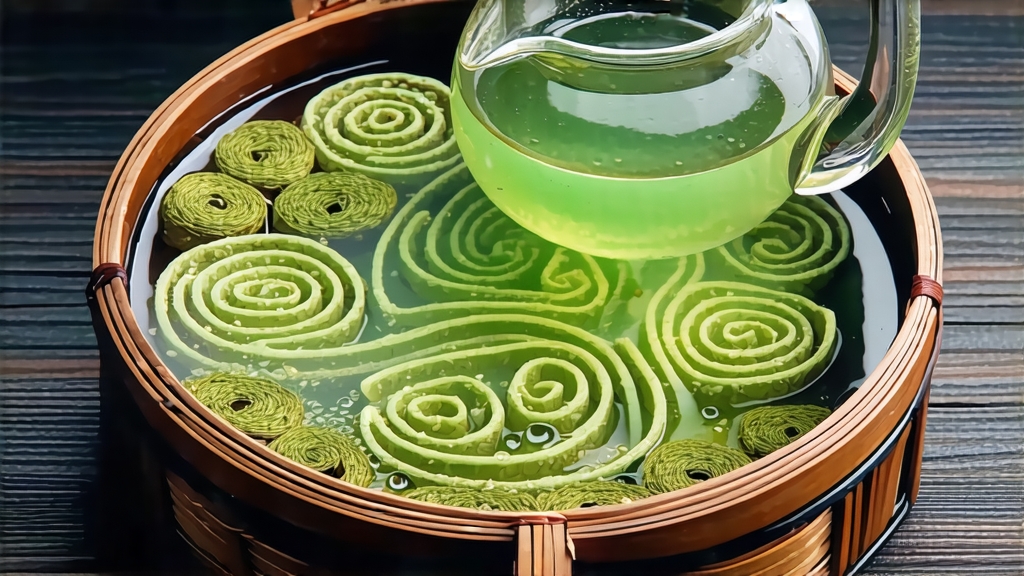
Among the pantheon of Chinese green teas, few names evoke as much poetry in miniature as Biluochun. Literally “Green Snail Spring,” the tea is prized for its tiny, spiral-shaped leaves, downy silver tips, and a fragrance so naturally sweet that early Qing-dynasty poets claimed it “borrows the scent of peach blossoms on the breeze.” To international drinkers accustomed to the grassy simplicity of sencha or the roasted heft of gunpowder, Biluochun offers a delicate paradox: the lightest of liquors carrying the most concentrated aromatics in the green-tea spectrum.
Origin stories swirl around the hills of Dongting Mountain, an island range rising from Taihu Lake in Jiangsu Province. One legend tells of a tea-picking girl who hid the fresh leaves in her bosom to protect them from mountain bandits; the warmth of her body accidentally fixed the green and released an intoxicating perfume. A more prosaic but verifiable account dates to the late Ming dynasty, when local monks began firing the leaves in small woks after noticing that cooler lake mists preserved higher levels of floral volatiles. By 1699 the Kangxi Emperor, touring the lower Yangtze, christened the tea “Biluochun” after its snail-shell curl and spring harvest, elevating it to tribute status.
Strictly speaking, only leaf plucked within the 12,000 mu (≈2,000 acres) of Dongting’s East and West mountains can claim the protected designation “Original Biluochun.” Yet the cultivar itself—traditionally a seed-propagated population known locally as “Xiao Ye” (small leaf)—has migrated to Zhejiang, Sichuan, and even Yunnan, giving rise to off-mountain styles that trade terroir-driven nuance for affordability. Purists divide the genuine article into three micro-categories: Mingqian (pre-Qingming, the rarest), Yuqian (pre-Grain Rain), and Chunwei (late spring). Each step down the calendar yields larger, less fragrant leaves and a paler infusion.
The crafting of Biluochun is a ballet of temperature and timing carried out within hours of plucking. Pickers work at dawn, selecting only the “one bud with one unfolding leaf” standard, ideally 1.5–2.0 cm in length. The harvest is immediately spread in bamboo trays no thicker than 2 cm to wither under mountain shade; direct sun is avoided to retain the highest possible chlorophyll and amino acids. Once the leaf loses about 10 % of its moisture and becomes supple, the kill-green phase begins. Using woks heated to 180 °C, artisans toss 100 g batches by hand, a motion called “tui na” (push-grasp) that lasts 3–4 minutes. The goal is not mere enzyme deactivation but the co-evaporation of grassy hexenals and the concentration of linalool and geraniol, compounds responsible for the tea’s signature peach-apricot note.
Immediately after kill-green the leaves are rolled while still above 60 °C. A skilled maker employs three distinct pressures: light coaxing to shape the curl, medium torque to break surface cells and release sap, and finally a whisper touch to set the spiral. The entire rolling cycle takes 10–12 minutes, after which the leaf is re-fired at 70 °C for 30 minutes to lower moisture to 6 %. The finished tea resembles tiny jade snails, each covered in a silvery trichome “down” that glistens under light.
Brewing Biluochun demands restraint. Its delicacy is easily bullied by hard water or overheated kettles. Begin with a tall, clear glass or a 150 ml gaiwan so the visual drama can unfold. Weigh 3 g of leaf—about one level teaspoon—and pour 200 ml of water at 75 °C. The first infusion should steep no longer than 45 seconds; watch as the spirals descend like green meteors, slowly unfurling into miniature lotus leaves. The liquor glows pale chartreuse, releasing an aroma that oscillates between white peach, ripe loquat, and a faint suggestion of sweet pea. On the palate it enters silky, almost weightless, then gathers into a cool, mineral snap reminiscent of wet slate.
Subsequent infusions can be staggered at 30-second increments, but stop after the fourth pour when amino acids are depleted